On May 27, 1934 the German racing cars that were soon to acquire the nickname “Silver Arrow” were entered for their first race, on the Avus racetrack in Berlin. Although neither Auto Union nor Mercedes-Benz won that event, it was not long before these two manufacturers began to dominate international Grand Prix racing, a situation that prevailed until the outbreak of the Second World War in 1939. It seems almost incredible today, but by 1936 the Silver Arrow racing cars were reaching speeds of up to 380 kilometres an hour on the long straights of the Avus circuit. The esteem in which these models and their drivers were held was based on their superb technology, which was way ahead of its time, and their drivers, whose courage is still an inspiration to subsequent generations of drivers. Yet it is not only the beauty of these automobiles that inspire awe, it also the rich history that comes along with them.
Mercedes-Benz and Auto Union race cars from the 1930s took to the track at the 2012 Goodwood Revival, some 75 years after the famed Silver Arrows first appeared in the United Kingdom. The Silver Arrows featured at the Revival were some of the most iconic of that wonderful era of racing. Audi Tradition saw their rear-engine Auto Union Type A, Type C, and monstrous Type D Dual Compressor hit the track against their former rivals, the front-engine Mercedes-Benz W 25, W 125, W 154 and W 165. While Auto Union achieved early head-to-head success, Mercedes-Benz racers claimed victory over several of the biggest races of the mid-to-late 1930s.
Piloted by experienced, world-famous drivers, the Silver Arrows staged several demonstration runs over the Goodwood Revival 2012, providing all the spectacle of a real race, but without risk to these priceless and irreplaceable pieces of motorsport history. Behind the wheel for the demo runs at Audi included Formula 1 legend Jacky Ickx, five-time Le Mans winner Frank Biela and arch enthusiast Nick Mason, while Jochen Mass, Karl Wendlinger, Jackie Stewart and his son Paul led the team driving the Silver Arrows from Mercedes-Benz. (See Goodwood Revival 2012 – Silver Arrows Race Report)
Silver Arrows at the 2012 Goodwood Revival – Paddock Pictures










The unauthorized use and/or duplication of any editorial or photographic content from sportscardigest.com without express and written permission from the publisher is strictly prohibited. Excerpts and links may be used, provided that full and clear credit is given to sportscardigest.com with appropriate and specific direction to the original content.
Silver Arrows at the 2012 Goodwood Revival – Mercedes-Benz W 25, 1934
In autumn 1932, the motor sport body AIACR (Association Internationale des Automobile Clubs Reconnus) in Paris announced a new formula for Grand Prix races that was to come into force in 1934. The rules stipulated a maximum weight of 750 kilograms without fuel, oil, coolant, and tyres, but otherwise no restrictions for the constructors. In 1933, Mercedes-Benz made the decision to develop a new racing car bearing the designation W 25. Initial test drives quickly showed that this was a car destined for victory, thanks to its combination of slim body, mechanically supercharged 3.4-litre in-line eight-cylinder engine producing 354 bhp (260 kW), individual wheel suspension, and direct rear axle transmission.
Mercedes-Benz also decided on a new chassis colour for the W 25 – silver. Its debut had been planned for the Avus race in Berlin in May 1934, but the team had to withdraw at the last minute because of technical problems. As a result, the new car made its first appearance one week later, at the International Eifel race at the Nürburgring on 3rd June. The W 25 lined up at the start in silver – supposedly, as legend has it, after the cars on the Nurburgring had been stripped of their white paint for weight reasons. Even though this race was not run in accordance with the 750-kg formula, the team was clearly determined to present a car that met the new regulations. The name “Silver Arrow” was coined some time later and gradually caught on over the years.








The unauthorized use and/or duplication of any editorial or photographic content from sportscardigest.com without express and written permission from the publisher is strictly prohibited. Excerpts and links may be used, provided that full and clear credit is given to sportscardigest.com with appropriate and specific direction to the original content.
Silver Arrows at the 2012 Goodwood Revival – Auto Union Type A, 1934
Originally manufactured in 1934, the Auto Union Type A was designed by Ferdinand Porsche. It had a 4.4-litre V16 engine that sat behind the driver in order to capitalize on weight distribution.
During the 1934 Avus race, the new Auto Union racing cars put up a most impressive show. Even during practice, Hans Stuck’s average lap speed of 245 km/h had made it clear who was the fastest contender. Although the race itself was held in heavy rain, Auto Union outpaced the other entrants. By the tenth lap, Stuck had built up a whole minute’s lead over his nearest rivals – but then a fault developed.
Though the Type A would become successful in breaking three world records, its speed was inferior to the front-engine design of its rival, Mercedes-Benz. Thus, Ferdinand Porsche was forced to redesign the Silver Arrow with a speed increase as the highest priority.







The unauthorized use and/or duplication of any editorial or photographic content from sportscardigest.com without express and written permission from the publisher is strictly prohibited. Excerpts and links may be used, provided that full and clear credit is given to sportscardigest.com with appropriate and specific direction to the original content.
Silver Arrows at the 2012 Goodwood Revival – Mercedes-Benz W 125, 1937
A deafening roar erupts from the 600 bhp (441 kW) supercharged engine of the new Mercedes-Benz Silver Arrow as it makes its debut on 9 May 1937 at the Tripoli Grand Prix. This was the call of the ultimate racing car of 1937. Because not only did the Mercedes-Benz W 125 clinch victory in its debut race (with Hermann Lang at the wheel), but it went on to win many other competitions that year. Rudolf Caracciola drove the car to three victories in five races for Mercedes-Benz on his way to winning another European Championship.
It took great passion and engineering expertise to build this Grand Prix racer, which was based on an entirely new design. By going to great lengths in designing the car completely from scratch, the Mercedes-Benz racing department demonstrated a huge amount of faith in their new competition vehicle. After all, the W 125 was developed specifically for a single year – 1937 – the fourth and final season of the 750-kilogram formula. After three years of using the W 25, Mercedes-Benz entered a brand new racing car just as this great era drew to a close – it was a move that brought a huge amount of success.








The unauthorized use and/or duplication of any editorial or photographic content from sportscardigest.com without express and written permission from the publisher is strictly prohibited. Excerpts and links may be used, provided that full and clear credit is given to sportscardigest.com with appropriate and specific direction to the original content.
Silver Arrows at the 2012 Goodwood Revival – Auto Union Type C, 1936
Bernd Rosermeyer’s ascension to world champion came in the seat of the Auto Union Type C, as this car reigned from 1936 to 1938, winning six races. The third design of Ferdinand Porsche’s Auto Union Silver Arrows maximized weight to power ratio, as the engine grew in this model but the chassis and body shrunk. The size changes and weight distribution made the Type C extremely difficult to maneuver; very few drivers could decipher its nuances to maximize on its capabilities.







The unauthorized use and/or duplication of any editorial or photographic content from sportscardigest.com without express and written permission from the publisher is strictly prohibited. Excerpts and links may be used, provided that full and clear credit is given to sportscardigest.com with appropriate and specific direction to the original content.
Silver Arrows at the 2012 Goodwood Revival – Mercedes-Benz W 154, 1939
In September 1936, the AIACR laid down the Grand Prix formula that was to apply from 1938. The key points were a maximum displacement of 3 litres for mechanically supercharged engines and 4.5 litres for naturally aspirated engines, and weight from a minimum of 400 kilograms to a maximum of 850 kilograms, according to displacement. These specifications necessitated a completely new car, so the 1937 season was still in full swing when the Mercedes-Benz designers developed their car for the next racing season. The V12 engine of the new W 154 was run on the test bench from January 1938. During the races, drivers of the car had more than 468 hp (344 kW) at their disposal.
The W 154 Silver Arrow was indeed able to outdo the exploits of its predecessors, giving the Mercedes-Benz racing department its greatest number of victories during this era. The first race of the new season ended in disappointment, however. On the twisting circuit in Pau, France, the car was unable to display its full potential and was set back by a refueling stop. But things rapidly improved thereafter. Mercedes-Benz won almost all major competitions that season and in 1939, the final racing season before the Second World War, Brauchitsch, Caracciola, and Lang repeated their triumphs of the previous year in the W 154.












The unauthorized use and/or duplication of any editorial or photographic content from sportscardigest.com without express and written permission from the publisher is strictly prohibited. Excerpts and links may be used, provided that full and clear credit is given to sportscardigest.com with appropriate and specific direction to the original content.
Silver Arrows at the 2012 Goodwood Revival – Auto Union Type D and Type D Dual Compressor, 1939
The Type D Dual Compressor was the last of the Silver Arrows. It came on to the racing scene midway through the 1939 season of the Belgian Grand Prix. The original Type D had a 12-cylinder engine that produced 420 hp, and gained an extra 65 hp with the introduction of the dual-compressor. Modifications to the body were also made after the engine received the dual-compressor boost. The replica, manufactured by Audi, was driven by Nick Mason, drummer of Pink Floyd, at the 2012 Goodwood Revival.
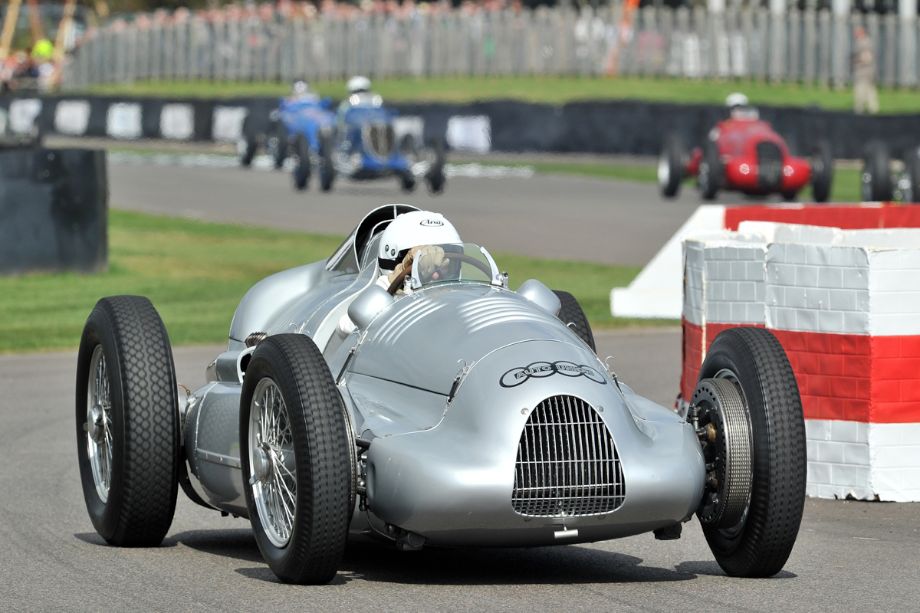









The unauthorized use and/or duplication of any editorial or photographic content from sportscardigest.com without express and written permission from the publisher is strictly prohibited. Excerpts and links may be used, provided that full and clear credit is given to sportscardigest.com with appropriate and specific direction to the original content.
Silver Arrows at the 2012 Goodwood Revival – Mercedes-Benz W 165, 1939
The W 165 formula racing car was developed by Mercedes-Benz in less than eight months to accommodate new rules which had been changed at short notice in 1939 for the Italian Grand Prix races organised by the Italian motorsports association. This included the prestigious Tripoli Grand Prix in Libya, then an Italian colony. These rules stipulated a maximum displacement of just 1.5 litres (rather than 3 litres).
For the new 1.5-litre engine, the engineers led by Max Sailer decided on an M 165 V8 unit producing 254 hp (187 kW). The right-hand cylinder bank of the short-stroke, 90-degree engine was positioned 18 millimeters further forward. The design of the frame and suspension was based on the three-litre W 154: an oval tubular frame with cross-members made of chromium-nickel-molybdenum steel, a De Dion rear axle with torsion bar suspension and a wishbone suspension with coil springs at the front. From the outside, the smaller Mercedes looked like its big brother, the W 154, although for reasons of space the driver in the W 165 sat slightly to the right.
Two W 165 cars raced at Tripoli, resulting in a famous double win for the marque with Hermann Lang coming first with an average speed of just under 198 km/h and Rudolf Caracciola finishing in second place.






The unauthorized use and/or duplication of any editorial or photographic content from sportscardigest.com without express and written permission from the publisher is strictly prohibited. Excerpts and links may be used, provided that full and clear credit is given to sportscardigest.com with appropriate and specific direction to the original content.
[Source: Daimler AG; Audi AG; photos: Tim Scott; Julien Mahiels]


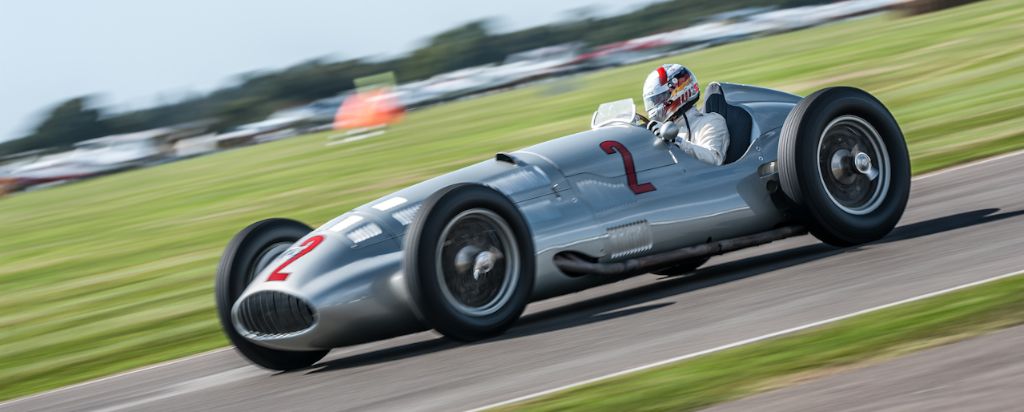

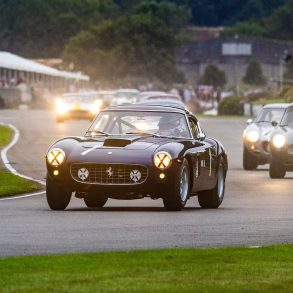
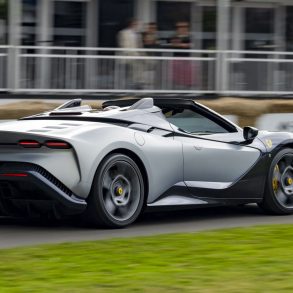
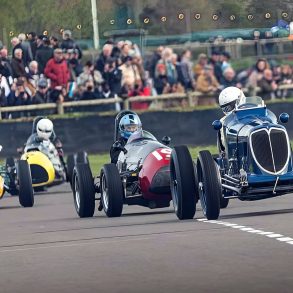

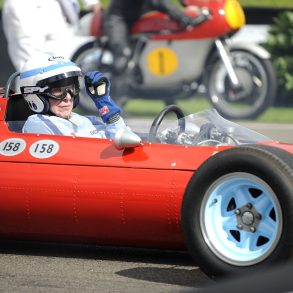


Great photo gallery and history of these awesome machines. Thanks to all involved for putting this together!
As David Hinshaw says, “Great photo gallery and history of these awesome machines. Thanks to all involved for putting this together!” Good also to see Stuck (senior!) in hill-climbing and also Luigi Fagioli who always seemed to be overshadowed by Caracciola and Seaman in pre-war racing and by Fangio and Farina in 1950-1951. A driver who deserves to be remembered more than he is. An article for your site, maybe?
There seems to be some confusion about identifying photos of W25’s and W125’s.